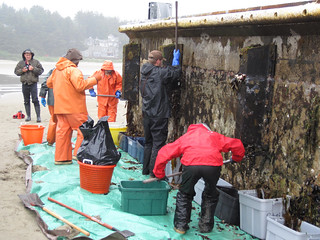 AGATE BEACH – A large section of a dock, ripped from the Japanese shore by last year’s tsunami and washed up this week on the Oregon coast, brought with it a host of potentially unwelcomed visitors.
AGATE BEACH – A large section of a dock, ripped from the Japanese shore by last year’s tsunami and washed up this week on the Oregon coast, brought with it a host of potentially unwelcomed visitors.
Scientists at OSU’s Hatfield Marine Science Center said the cement float contains about 13 pounds of organisms per square foot – an estimated 100 tons of wet plant and animal life. As of Thursday they had gathered living samples sample of multiple species of barnacles, starfish, urchins, anemones, amphipods, worms, mussels, limpets, snails, solitary tunicates and algae – and there are dozens of species overall.
“This float is an island unlike any transoceanic debris we have ever seen,” said John Chapman, an OSU researcher who studies marine invasive species . “Drifting boats lack such dense fouling communities, and few of these species are already on this coast. Nearly all of the species we’ve looked at were established on the float before the tsunami; few came after it was at sea.”
Chapman said it was “mind-boggling” how these organisms survived their trek across the Pacific Ocean. The low productivity of open-ocean waters should have starved at least some of the organisms, he said.
“It is as if the float drifted over here by hugging the coasts, but that is of course impossible,” Chapman said. “Life on the open ocean, while drifting, may be more gentle for these organisms than we initially suspected. Invertebrates can survive for months without food and the most abundant algae species may not have had the normal compliment of herbivores. Still, it is surprising.”
Jessica Miller, an Oregon State University marine ecologist, said that a brown algae (Undaria pinnatifida), commonly called wakame, was present across most of the dock – and plainly stood out when she examined it in the fading evening light. She said the algae is native to the western Pacific Ocean in Asia, and has invaded several regions including southern California. The species identification was confirmed by OSU phycologist Gayle Hansen.
“To my knowledge it has not been reported north of Monterey, Calif., so this is something we need to watch out for,” Miller said.
Miller said the plan developed by the state through the Oregon Department of Fish and Wildlife and Oregon State Parks is to scrape the dock and to bag all of the biological material to minimize potential spread of non-native species. But there is no way of telling if any of the organisms that hitchhiked aboard the float from Japan have already disembarked in nearshore waters.
“We have no evidence so far that anything from this float has established on our shores,” said Chapman. “That will take time. However, we are vulnerable. One new introduced species is discovered in Yaquina Bay, only two miles away, every year. We hope that none of these species we are finding on this float will be among the new discoveries in years to come.”
Read the complete story from OSU News & Research Information
(Photo credit: OSU Hatfield Marine Science Center, Newport)
 Award-winning Oregonian cartoonist Jack Ohman takes on this week’s Oregon Sea Grant report linking school science classrooms spread of invasive species, with pinpoint humor. (Click on image to enlarge)
Award-winning Oregonian cartoonist Jack Ohman takes on this week’s Oregon Sea Grant report linking school science classrooms spread of invasive species, with pinpoint humor. (Click on image to enlarge)





